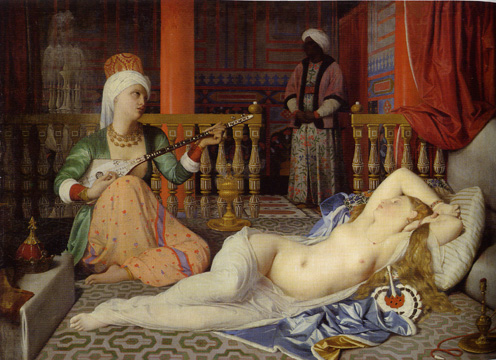During the early years of the twentieth century a wealthy New Yorker named Grenville L. Winthrop assembled a remarkable collection of nineteenth-century French, British and American paintings and drawings. In 1943 he bequeathed it to Harvard University, his alma mater, and until now it has never been lent or exhibited abroad. But in two weeks time a selection of the collector’s best acquisitions will be placed on display at the National Gallery in London. Today’s picture is one of my favourites from the Winthrop hoard: Odalisque with Slave, by Jean-Auguste-Dominique Ingres. It was painted in 1839.
Ingres was nearly sixty at the time and had recently been appointed Director of the French Academy in Rome. The position meant a lot to him, since he had always worked hard to present himself as a standard-bearer for traditional academic values. He was known publicly as the great upholder of le pur classique as well as the most vociferous opponent of Romanticism and its excesses, personified by Ingres’ arch-rival and opponent Delacroix, painter of rape and murder and affray, in the hues of blood and fire. “I smell brimstone,” Ingres used to say, whenever Delacroix walked into the room. But the picture reproduced here, a dreamily erotic, sensually overloaded fantasy of a concubine’s life in some imaginary Near Eastern harem, shows that Ingres himself was a more passionate and romantic artist than he cared to admit. As the poet and art critic Charles Baudelaire perceptively noted, “one of the things that distinguishes Monsieur Ingres is his love of women: his libertinism is serious and full of conviction.”
Odalisque with Slave is an Aladdin’s cave of sensual enticements, set in a space decorated by a proliferation of dancing patterns and designs, painted in such a profusion of sharp and bright...


